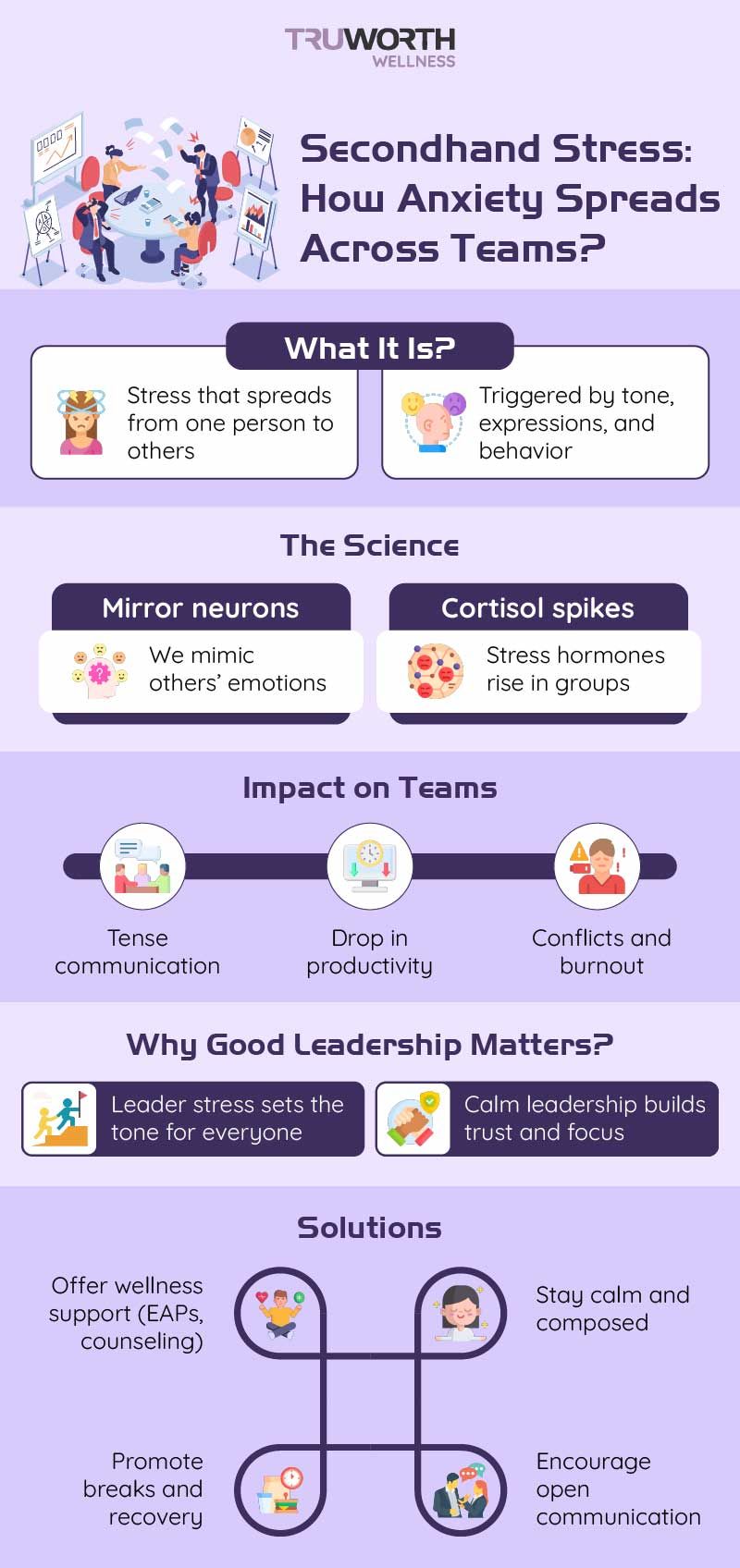The Science Of “Secondhand Stress”: How One Person’s Anxiety Affects An Entire Team?

Stress is often seen as a personal struggle, something individuals manage quietly while still performing their roles. But science tells us otherwise. Stress doesn’t stay contained within one person. Like secondhand smoke, stress can spread invisibly to others, affecting team dynamics and workplace culture. This phenomenon is called secondhand stress, and its impact is far-reaching. If ignored, it can reduce productivity, fuel conflicts, and accelerate burnout across entire teams. Understanding how secondhand stress works is the first step toward building healthier organizations.

What Exactly Is Secondhand Stress?
Secondhand stress occurs when one person’s anxiety, frustration, or tension is picked up by others around them. It doesn’t require words. Facial expressions, tone of voice, and body language are often enough to transmit unease.
For example, imagine a manager overwhelmed with deadlines, entering a meeting visibly agitated. Within minutes, the room feels tense, even though no one has spoken about the cause. Psychologists call this emotional contagion, the process by which humans “catch” emotions from those around them. Over time, this ripple effect shifts the mood of an entire workplace.
The Science Behind It
Mirror neurons play a crucial role. These are brain cells that fire both when we take an action and when we observe the same action performed by someone else. If a colleague shows visible anxiety, your brain simulates that state, making you feel uneasy too.
Stress is not just psychological; it is biological. Elevated cortisol levels in one individual can lead others to experience hormonal changes, putting their bodies on alert.
Behaviorally, stressed employees may become curt in communication, rush tasks, or react impatiently. These behaviors push others into defensive or rushed states, creating a feedback loop where stress feeds on itself.
Real World Examples
A leader overwhelmed with tasks may communicate in urgent tones, triggering anxiety in team members even if their workloads are manageable. A remote team member sending late, anxious messages can unsettle others. In hybrid settings, delayed responses, unclear expectations, or abrupt scheduling raise stress not just in that team member but across collaborators reliant on them.
According to Gallup’s State of the Global Workplace 2023 Report, 44% of employees globally say they are stressed. Stress levels have been rising for the past decade (Gallup). Harvard Business Review reports similarly: 44% of employees say they experienced stress “a lot” during the previous day (HBR).
How Secondhand Stress Impacts Teams?
Tense communication becomes common as decisions are rushed, requests feel abrupt, and tones become impatient. Productivity suffers because mental energy is diverted from creative or analytical tasks to managing emotional fallout. Conflicts that would have been minor escalate under the weight of cumulative tension. Long exposure leads to burnout contagion. Even employees with balanced roles may burn out when constantly exposed to a high-stress environment. Secondhand stress undermines innovation, collaboration, and employee retention.
Why Leaders Must Take It Seriously?
Leaders often underestimate how their emotional state influences their teams. Research shows that when leaders behave anxiously, it lowers employee morale and performance. Acting calmly during crises sends a message that challenges are manageable.
Leading by example matters. If leaders normalize crisis or constant pressure, teams internalize that anxiety is the norm. Over time, this erodes trust, increases turnover, and damages organizational culture.
Strategies to Prevent and Manage Secondhand Stress
- Model calm leadership. When leaders stay composed, even under pressure, they provide emotional signals that help teams regulate their stress.
- Acknowledge stress openly. Recognizing stress doesn’t show weakness; it signals psychological safety and encourages others to voice concerns before they build up.
- Encourage healthy communication. Use a mindful email tone, avoid urgency unless needed, hold meetings with clarity, and set realistic expectations.
- Create recovery moments. Short breaks, walking meetings, breathing exercises, and stretch sessions can interrupt stress transmission.
- Provide stress awareness training. Workshops on emotional intelligence help people recognize stress in themselves and others, and develop healthier coping mechanisms.
- Strengthen organizational support. Employee Assistance Programs (EAPs), counseling services, and wellness initiatives give tools to manage stress before it spills over.
- Review workload distribution. Uneven workloads often make one person the stress epicenter. Regular reviews help spread pressure more evenly.
The Bigger Picture
Secondhand stress is not just a personal issue but a cultural one. A workplace where anxiety spreads unchecked will struggle with innovation, collaboration, and long-term engagement. Companies that proactively address secondhand stress foster resilience, empathy, and trust. Employees don’t just feel better, they perform better, collaborate more effectively, and stay longer.